The year 2020 gone down in history as one of the most difficult years that our combined generations have lived through. We have yet to see what the final death toll from COVID-19 is going to be. But there’s another toll that will have to be tallied as well; that’s the effect that months of a shutdown are going to have on the national and global economy. Are we going to end up in a global depression?
But probably the most memorable thing that 2020 will be known for, more than even the pandemic, is as the year of the Great American Toilet Paper Shortage.
For some unknown reason, the panic associated with the COVID-19 pandemic has sparked a run on toilet paper, even though it is a respiratory disease and not a gastrointestinal one.
We may never know what has caused the Great American Toilet Paper Shortage; but we’re going to have to live with it.
That either means getting up at a ridiculous hour of the morning, in order to stand in line outside the grocery store, watching the sun rise and hoping that the store will have received some toilet paper overnight. If luck is with you, you’ll only have to do that once; but if not, you may have to do it several days in a row, in order to get your hands on some of those precious rolls.
That almost sounds a bit like a craps game; you pay your money and you take your chances. On the other hand, you can go with one of the other options out there. Some people are touting the idea of using cloth and leaves, in place of toilet paper. After all, we haven’t always had toilet paper to use and people had to use something.
Too bad Sears isn’t still putting out their “big book” like they did for so many years.
Those adorned many an outhouse, alongside a burlap sack of corn cobs, once the new catalog came out. But we can’t count on Sears for that one anymore. If we want paper for our bums and can’t find it elsewhere, we’ll just have to make our own.
Actually, our own will probably be a whole lot better than the Sears catalogue anyway… and who wants to use a corn cob? Sounds scratchy!
What’s it Going to Take?
If you’re someone who collects newspapers for recycling, you’re in great shape. You already have the number one ingredient you need, so that you can make your own toilet paper. While you can use other kinds of paper to make your TP, newsprint will break down easier and produce a softer paper.
Besides newspapers, you’re going to need:
- More newspapers
- Water
- Bucket
- Paper shredder
- Electric mixer
- Plastic storage bin
- Frame to fit in the storage bin
- Screen material
- Staple gun
- Putty knife
- Something to cut your TP with
- Something to roll your TP on
Making Your Own Toilet Paper
The first thing we need to do, in order to turn that newspaper into toilet paper, is to break the newspaper down. This can be easily done with water, especially if you give that water a little mechanical help.
- Shred the newspaper with a paper shredder. The smaller your paper shredder shreds the paper, the better. If you don’t have a paper shredder, you can cut or tear the newspaper into strips; but it might need to soak in water longer.
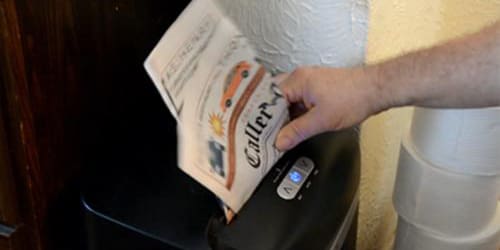
- Place your shredded newspaper in the bucket and cover it with water. You only need enough water to barely cover the shredded newspaper. Any more is a waste.
- Allow the newspaper to sit in the water for 24 hours.
- Using an electric mixer, chop up the wet newspaper, making it into pulp.
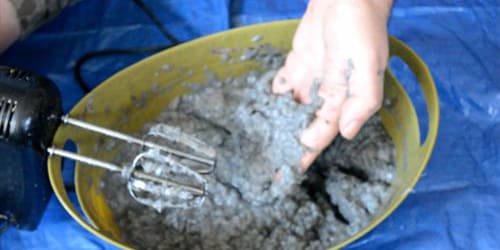
While your newspaper is soaking, it’s a good time to make your screen frame. It needs to be as big as possible, but still sit in the bottom of your plastic storage bin. I used 1”x 2” pine for this, but you can use wider boards if you want to. There are a number of different ways you can assemble this frame, but the easiest way is to make butt joints in the corners and pin them with dowels, as I show in the video.
The reason I chose to dowel the corners of the frame was that glue doesn’t stick well to end grain.
This frame is going to sit in water and I don’t want the joint to loosen up. Screws don’t work well into end grain either, although nails do. So you could choose to nail it, but it’s just as easy to use dowel pins.
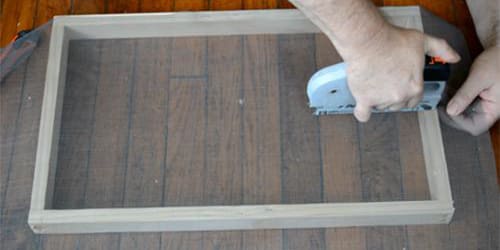
To dowel a joint of this type, first clamp the two parts making the corner of the frame, so that they are positioned properly, with the edges flush.
Then drill two holes of the appropriate size for the dowel being used. I used 3/8” dowels, so I drilled my holes with a 23/64” drill bit, drilling through the lap board, into the end grain of the other board. I made sure to drill the holes deeper than the length of the dowels.
With the holes drilled, I spread glue into the splines cut into the sides of the dowel pins with my finger. I then placed them in the holes and drove them flush with a wood mallet. Once all the corners were properly pinned together, I set the frame aside to dry.
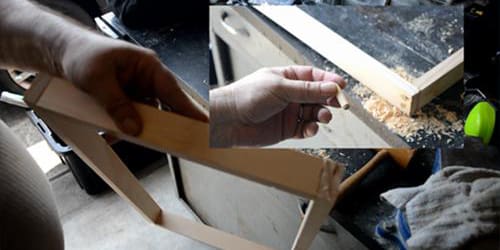
Finally, staple screening material onto one side of the frame, working from the center outwards.
It doesn’t need to be as tight as what you would do for a window, but it should be flat and smooth. If your staples don’t go all the way in, hammer them flush with the top of the wood, so that they will grip the screening properly.
Now that your newspaper pulp and your frame are ready, it’s time to make the toilet paper.
- Place your frame into the bin and fill it with water. Ideally, the water should come to just below the top of the frame.
- Scoop up a portion of the newspaper pulp, roughly equal to two cups (the quantity isn’t exact, as your bin might be a different size than mine) and put it in the water, mixing it with the water and spreading it out to fill the entire area.
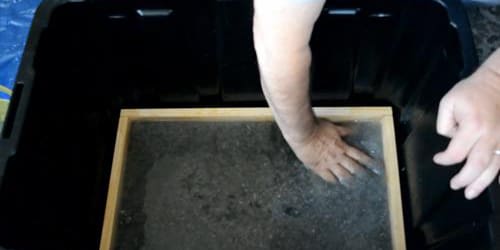
- Slowly lift the frame out of the water, looking to see, as the water drains out, that the shredded newspaper pulp is evenly spread across the entire are of the screening.
- Allow as much water as possible to drain out of the newspaper pulp.
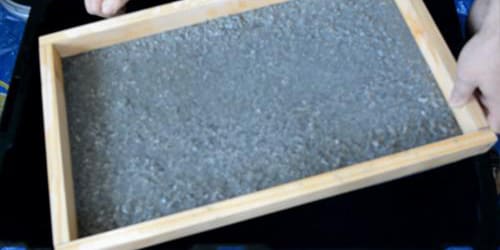
Now we need to dry the pulp, allowing it to bond back together and turn into paper.
- Set up an ironing board and cover it with a piece of absorbent cloth. An old towel will work. Place the frame, screen side down, on top of this cloth.
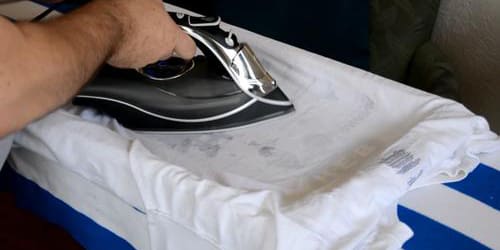
- Place another absorbent, but smooth cloth on top of the newspaper pulp inside the frame. An old T-shirt will work.
- Using a clothes iron, set for ironing cotton, iron the cloth, heating the newspaper pulp and drawing the moisture out of it. You’re trying to do two things here; one is to draw the moisture out, and the other is to flatten the surface of the paper. If you don’t iron it, you’re going to end up with some rather scratchy paper.
- Place the frame in the sun to finish drying. You could try drying it all the way with the iron, but that will take a long time.
With the paper dry, we’re ready to make it usable in the bathroom.
- Take a wide putty knife, preferably a plastic one, and use it to break your sheet of toilet paper free of the frame around the edges. Be careful not to cut through the screen, so that you can reuse it.
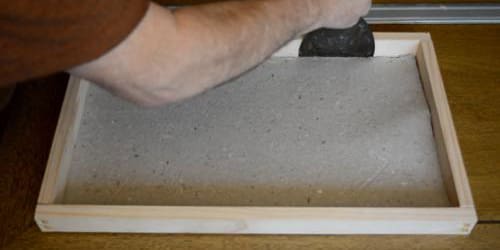
- Flip the frame over so that the screen side is up and push down gently on the screen, all around the edges. This should break the paper free from the screen. Continue through the middle of the paper as well.
- Flip the frame back over, paper side up and work one corner of your paper free, then pull up the rest, taking care not to tear it.
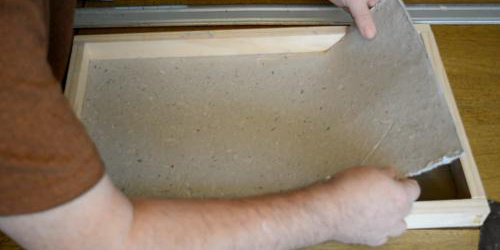
- Measure the paper, marking it to the width of a toilet paper roll. If you don’ t have any toilet paper rolls to put your homemade TP on, you can cut paper towel or wrapping paper rolls down to four-inch segments.
- Roll the paper onto the cardboard tube, overlapping pieces over each other.
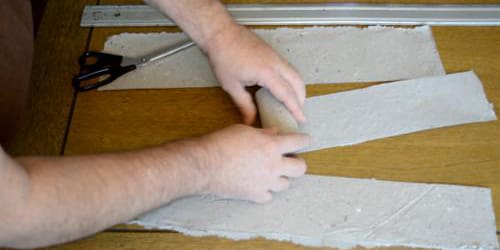
Your finished toilet paper is going to be thicker than store-bought, even though it is only one single ply.
That means you can use less of it, which I’d recommend, considering that it’s a bit harder to make than just going to the store and buying a four-pack of Charmin. But then, if you could do that, you wouldn’t need to make your own.
This article first appeared on AskAPrepper.
You may also like:
How To Build An Outdoor Mud Oven
How to Build a Native American Subterranean Roundhouse in Your Backyard (Video)
40 Uses For Sawdust Around Your Homestead
The Forager’s Guide To Wild Foods: Book Review
Ingenious Ways To Use Toilet Paper Rolls That You Never Thought Of
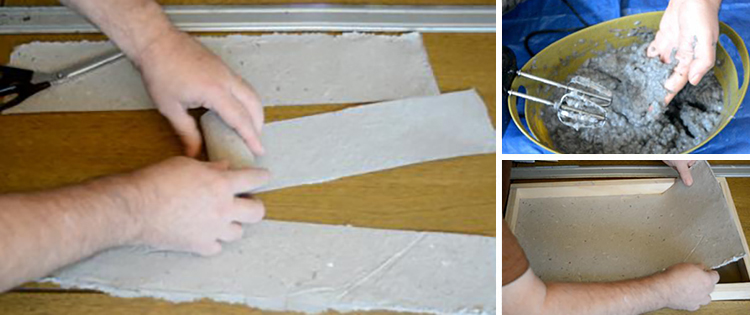








I notice this requires multiple uses of electricity. How would one do this, WITHOUT electricity?
Rolling pin and sunshine, Orwell and bucket or pond. If no newspaper then tree bark shavings
Valid question!
We purchased a portable bidet. $12 on Amazon.
Wash your bum off with clean water and dry off with a washcloth. Microfiber washcloths are fantastic: super cheap, soft and extremely durable. Rinse the washcloth out and hang it up to dry after each use. Very easy and sanitary.
using washable bits of cloth is much less labor intensive- cut up old clothes that become rags -wash as needed